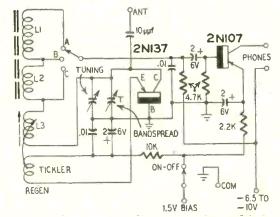Sixty years ago this month, the August 1956 issue of Radio Electronics carried the plans for this receiver, which was probably the first, or one of the first, examples of an all-transistor shortwave receiver. Up until this point, high-frequency oscillation had been the stumbling block for a transistorized receiver. But GE had just put on the market the 2N137, and the circuit shown in the article could oscillate up to 12 MHz, and could even function at higher frequencies with less sensitivity.
The transistor had a steep retail price of $6.50, but this was predicted to drop as demand and production grew.
The author described the set as “a real ‘red hot,'” and reported that the dial was usually crowded with hundreds of stations. With an antenna consisting of 8 feet of wire on the floor, the set consistenly pulled in European and Asian stations and could keep pace with many communications receivers. It also performed well on the standard broadcast band.
The set used band switching, and had tuning ranges of 800-1600 kHz, 3.8-6.5 MHz, and 6-13 MHz. Regeneration was adjusted by means of variable inductive coupling, and the author reported smooth operation, even better than most vacuum tube circuits. The tickler coil was mounted on a plastic shaft, and could be rotated from the front panel to adjust the orientation with respect to the antenna coil. One stage of audio amplification (with a 2N107, kept the headphones isolated from the detector and almost eliminated the tendency for movement of the headphone cord to affect tuning.
The author suggested that the use of plug-in coils might push the operation of the set to higher frequencies, but the plans shown were a good starting point for anyone interested in the use of transistors at high frequencies. It resulted in a good portable radio that was both rugged and had very low power drain. He noted that these attributes made the set attractive for emergency or disaster use.
Click Here For Today’s Ripley’s Believe It Or Not Cartoon
![]()


